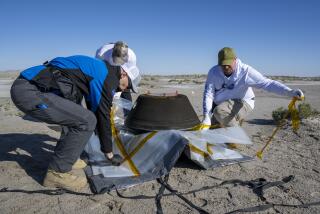Space Module Blazes a New Trail in Orbit
- Share via
BAIKONUR, Kazakhstan — Zarya, a high-tech space tugboat and control module, rose into the sky Friday from the wind-swept steppe of Central Asia, becoming the first segment of a new International Space Station to be launched into orbit.
With a burst of flame and a thunderous explosion, the unmanned, $300-million unit successfully reached orbit atop a Russian-made Proton rocket 14 years after NASA began drawing up plans to build a new space station.
“The International Space Station is going to be a reality,” NASA Administrator Daniel S. Goldin proclaimed here after the launch. “We are doing it. We are not debating it anymore. It’s a done deal.”
Unlike any previous space project, the new station has brought together 16 countries in a multinational partnership that has transformed the exploration of space into a global effort.
The station, which will be put together in space from more than 100 segments, is designed to serve as an orbiting laboratory that will lay the foundation for the habitation of space, Goldin said.
Top U.S. and Russian space officials who came to the Baikonur Cosmodrome to witness the liftoff of Zarya--Russian for “dawn”--hailed it as one of the most important aerospace events since the United States and the Soviet Union began their space race 40 years ago.
“This represents our two countries coming together in one program,” said George Abbey, director of the Johnson Space Center in Houston. “That’s going to be the space program of the future. We’re going to approach things internationally.
“If you look back through the history of the launches we’ve done, it’s probably as significant as John Glenn’s flight was back in 1962,” he added, referring to the first American to orbit the Earth.
Zarya was launched from a space complex already imbued with history. This is where the Soviet Union launched Sputnik, the world’s first satellite, in 1957. It is also where cosmonaut Yuri Gagarin took off in 1961 on the first human flight into space.
Later, the Soviet Union launched a series of space stations from Baikonur, including the Mir station that is still functioning after nearly 13 years in orbit.
Today, the Baikonur Cosmodrome has disintegrated into a seedy, rundown collection of ramshackle apartment buildings, unused rocket platforms and garbage-strewn fields. Russia leases the facility from Kazakhstan, which acquired it with the breakup of the Soviet Union, but neither country has the money to keep it up.
Russian officials, struggling to maintain a space program at all, hope to recover some of their country’s past glory through the leading role Russia will play in the International Space Station.
Although the United States will pay most of the bill, Russia’s scientists can offer far more experience in designing, building and operating orbiting stations.
According to NASA, the station’s hardware alone will cost at least $40 billion, of which the U.S. will pay about 60%. This does not include the huge cost of shuttle flights to the station, its assembly and operation.
Some critics put the station’s total price tag at $100 billion and contend that the project should be abandoned because of the high cost. Goldin defends the station, saying that now is the time to start exploring the possibility of establishing human life beyond Earth.
“We are opening up a space frontier,” he said. “If we ever want to leave Earth orbit, we have to figure out how people can live and work safely and efficiently in space. You cannot do that on the ground. You have to do it in space.”
The space station will be built gradually over the next six years, eventually growing almost as large as two football fields. NASA officials say the solar-powered station will eventually become one of the brightest objects in the night sky.
It will take at least 45 launches of Proton rockets and U.S. shuttles to lift the 1 million pounds of hardware that will ultimately go into the station. Already, more than half the equipment has been built by the other participating nations--Canada, Japan, Brazil and the 11-member European Space Agency.
The Zarya module was built by workers in Russia under a contract managed by the Boeing Co. and paid for by the United States. It is meant to provide propulsion, power and communications in the early stages of the project.
The next scheduled launch to the station is Dec. 3, when the shuttle Endeavour is set to carry up a connecting U.S.-made node called Unity and hook it up to Zarya.
For at least seven months there will be a lull in construction, but the pace is supposed to pick up again in the summer, when a much-delayed Russian-made module with living quarters is scheduled for launch.
The first crew to occupy the station--consisting of one U.S. astronaut and two cosmonauts--is to fly to the station in January 2000 and live there for five months.
Ultimately, the station will have six laboratories and living quarters for seven astronauts. It is designed to operate at least until 2013.
“This is a tough program,” Goldin said. “This is exactly where NASA wants to be.”
More to Read
Sign up for Essential California
The most important California stories and recommendations in your inbox every morning.
You may occasionally receive promotional content from the Los Angeles Times.













